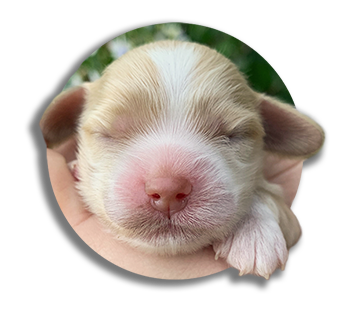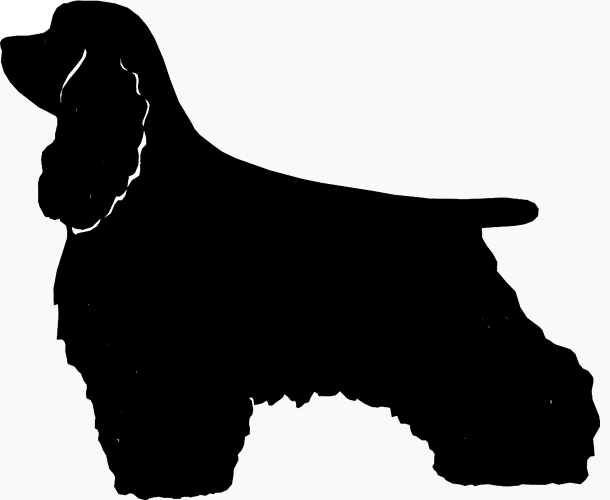
Health Testing
The health testing that can be done in our current day is a wonderful thing. In the past a genetic disease like PRA that causes blindness in older dogs would be hard to prevent in your breeding dogs, since they are retired from breeding by the time symptoms arise. But now a simple cheek swab can tell us if a puppy carries the genes for PRA. These advancements are still continuing as well--every year new diseases are added to the testing list. Sadly there are diseases, like cancer, that cannot be predicted or tested for in our breeding dogs, but the genetically simple ones are being tested for and removed from the breed whenever possible. On this page we'll go into detail on some of the diseases we test for and the associated risks.
Progressive Retinal Atrophy
Progressive Retinal Atrophy (PRA) is an inherited disease of the retina (eye) in dogs. Special cells used for sight in the eye begin to die, leading to blindness in the dogs. PRA is one of the more simple diseases genetically, as a dog can have 1 Copy of the PRA gene and be unaffected. Their healthy gene protects them and they have normal vision their whole life. When a dog inherits 2 Copies of the PRA Gene then they will sadly lose their vision at an older age.
PRA is commonly found in both Poodles and Cocker Spaniels, so it can be seen in Cockapoos. I am happy to report that all of our studs and cockapoo females have been cleared for the PRA Gene, meaning they only have healthy normal genes and cannot produce puppies with PRA. When we purchase purebred Cocker Spaniels as our future moms we have discovered that a couple carried 1 Copy of the PRA gene. Luckily with 1 Copy only they are unaffected. Havannah for example carries 1 Copy of PRA. When bred to a PRA Clear male we know that all puppies are guaranteed to be unaffected by PRA. We will always do our best to insure that all of our dogs are tested so we never breed two dogs who both carry PRA.

Cocker Spaniel Specific Diseases:
Autosomal Recessive Hereditary Nephropathy, Familial Nephropathy, ARHN
Exercise-Induced Collapse, EIC
Glycogen storage disease Type VII, Phosphofructokinase Deficiency, PFK Deficiency
Hereditary Sensory Autonomic Neuropathy, Acral Mutilation Syndrome, AMS
Bernard-Soulier Syndrome, BSS
Acral Mutilation Syndrome (GDNF-AS, Spaniel and Pointer Variant)
Our cocker spaniels have all been genetic tested for the above diseases. We are happy to report that all of our girls are unaffected by any of these diseases. They were completely clear except for two (Jenny & Confetti) who each carry 1 Copy of EIC. Like PRA, a dog carrying 1 Copy of EIC is unaffected and when bred to a Clear male is gauranteed to only have unaffected puppies. All of our Cockapoo studs are Clear for the above diseases.

Poodle Specific Diseases:
Von Willebrand Disease Type I, Type I vWD (VWF)
GM2 Gangliosidosis (HEXB, Poodle Variant)
Neonatal Encephalopathy with Seizures, NEWS (ATF2)
Osteochondrodysplasia (SLC13A1, Poodle Variant)
Degenerative Myelopathy, DM (SOD1A)
The Toy Poodle studs that we use as well as our Cockapoos have all been genetic tested for the above diseases. Wonderfully they are all Clear!
IVDD & CDDY Variant
Among all that good news there is one piece of information that I am sad to report. In Fall 2017 a research paper announced the discovery of a genetic risk factor for spinal problems in dogs (IVDD). Dogs who had an extra copy of the FGF4 gene on Chromosome 12 produced elevated levels of a particular protein that is linked to early vertebral ossification, called the CDDY Varient. First identified in Nova Scotia Duck Tolling Retrievers it was discovered that this Risk Factor was present in 100% of certain dog breeds. The gene was found to be present in almost every dog tested in the following breeds: Beagles, Corgis, King Charles Spaniels, Dachshunds, French Bulldogs, and Cocker Spaniels (American and English). These breeds have the genetic risk factor at a foundational level, rather then just a specific line or two having a mutation pop up later on.
When the testing looked into our breeds the American Cocker Spaniel was found to have 94% of dogs having the CDDY variant, and between 57-75% of Toy and Minature poodles. Genetic testing for breeders became available in Fall 2019, and as we tested our dogs both our Cocker Spaniels and Toy Poodles were all found to have CDDY Varient.
The hopeful news about the CDDY variant is that it is not a determinate gene like PRA. With PRA dogs that have 2 copies are guaranteed to become blind. With the CDDY Variant it is only a Risk Factor, not a diagnosis of IVDD. Other risk factors include environment, weight, and certain activities. For example repeated jumping from a high surface, quick turns on a slick floor, being overweight, etc can all contribute to IVDD. The best way to protect your dog is to:
Keep them fit and active.
Keep them at a healthy weight.
Avoid high impact activities.
In breeds where 100% of the dogs have the CDDY Variant what decides which of the dogs actually develop IVDD? Only a fraction of dogs in these breeds actually have diagnosed IVDD even though they all have the risk factor. Researchers are still searching for more contributing genes to better understand who will develop problems. In addition there are believed to be genetic protective factors that keep dogs healthy, they are just yet to be located.
Can we avoid the CDDY Variant?
Both Yes and No. In Cocker Spaniels, with a breed prevelance of almost 100%, it is unlikely that the CDDY variant can ever be cleared from the breed. Once further genes and protective factors are located breeders can select for them, but that is years away. In Toy & Minature Poodles the outlook is much better. When two poodles who both carry 1 Copy of the CDDY Variant are bred together 25% of the puppies are clear for the CDDY Variant. Now that genetic testing can be done on a litter of puppies Poodle breeders will be able to keep the CDDY clear puppies for breeding, and other several generations greatly reduce the number of poodles with the variant. Already breeders are locating and raising the CDDY clear puppies who will be the future generation.
Where does that leave Cockapoos? If a CDDY Variant Clear poodle is bred to a Cocker Spaniel who has the variant then all the puppies have the risk factor. Every F1 Cockapoo would then carry the same risk factor, regardless of if a clear poodle is used. As long as Cocker Spaniels are used to breed Cockapoos the risk factor cannot be removed entirerly. What we can do is select for F1 Cockapoo puppies who only carry 1 copy of the CDDY Variant. When those F1 Cockapoos are bred then 25% of the F2 puppies will be CDDY Clear. Then when those puppies grow up and are bred they can have F3 CDDY Variant Clear litters.
While this is our goal, it means that every F1 Cockapoo will carry the risk factor and only 2-3 generations of careful selecting will give us CDDY Variant Clear F3 litters. This process will need to be done by Cockapoo breeders everywhere if we are to have a genetic pool of Cockapoos that are not closely related.
If you would like to learn more about IVDD here is an informative video by a veterinarian: IVDD Disc Disease in Dogs
Progressive Retinal Atrophy (PRA) is an inherited disease of the retina (eye) in dogs. Special cells used for sight in the eye begin to die, leading to blindness in the dogs. PRA is one of the more simple diseases genetically, as a dog can have 1 Copy of the PRA gene and be unaffected. Their healthy gene protects them and they have normal vision their whole life. When a dog inherits 2 Copies of the PRA Gene then they will sadly lose their vision at an older age.
PRA is commonly found in both Poodles and Cocker Spaniels, so it can be seen in Cockapoos. I am happy to report that all of our studs and cockapoo females have been cleared for the PRA Gene, meaning they only have healthy normal genes and cannot produce puppies with PRA. When we purchase purebred Cocker Spaniels as our future moms we have discovered that a couple carried 1 Copy of the PRA gene. Luckily with 1 Copy only they are unaffected. Havannah for example carries 1 Copy of PRA. When bred to a PRA Clear male we know that all puppies are guaranteed to be unaffected by PRA. We will always do our best to insure that all of our dogs are tested so we never breed two dogs who both carry PRA.

Cocker Spaniel Specific Diseases:
Autosomal Recessive Hereditary Nephropathy, Familial Nephropathy, ARHN
Exercise-Induced Collapse, EIC
Glycogen storage disease Type VII, Phosphofructokinase Deficiency, PFK Deficiency
Hereditary Sensory Autonomic Neuropathy, Acral Mutilation Syndrome, AMS
Bernard-Soulier Syndrome, BSS
Acral Mutilation Syndrome (GDNF-AS, Spaniel and Pointer Variant)
Our cocker spaniels have all been genetic tested for the above diseases. We are happy to report that all of our girls are unaffected by any of these diseases. They were completely clear except for two (Jenny & Confetti) who each carry 1 Copy of EIC. Like PRA, a dog carrying 1 Copy of EIC is unaffected and when bred to a Clear male is gauranteed to only have unaffected puppies. All of our Cockapoo studs are Clear for the above diseases.

Poodle Specific Diseases:
Von Willebrand Disease Type I, Type I vWD (VWF)
GM2 Gangliosidosis (HEXB, Poodle Variant)
Neonatal Encephalopathy with Seizures, NEWS (ATF2)
Osteochondrodysplasia (SLC13A1, Poodle Variant)
Degenerative Myelopathy, DM (SOD1A)
The Toy Poodle studs that we use as well as our Cockapoos have all been genetic tested for the above diseases. Wonderfully they are all Clear!
IVDD & CDDY Variant
Among all that good news there is one piece of information that I am sad to report. In Fall 2017 a research paper announced the discovery of a genetic risk factor for spinal problems in dogs (IVDD). Dogs who had an extra copy of the FGF4 gene on Chromosome 12 produced elevated levels of a particular protein that is linked to early vertebral ossification, called the CDDY Varient. First identified in Nova Scotia Duck Tolling Retrievers it was discovered that this Risk Factor was present in 100% of certain dog breeds. The gene was found to be present in almost every dog tested in the following breeds: Beagles, Corgis, King Charles Spaniels, Dachshunds, French Bulldogs, and Cocker Spaniels (American and English). These breeds have the genetic risk factor at a foundational level, rather then just a specific line or two having a mutation pop up later on.
When the testing looked into our breeds the American Cocker Spaniel was found to have 94% of dogs having the CDDY variant, and between 57-75% of Toy and Minature poodles. Genetic testing for breeders became available in Fall 2019, and as we tested our dogs both our Cocker Spaniels and Toy Poodles were all found to have CDDY Varient.
The hopeful news about the CDDY variant is that it is not a determinate gene like PRA. With PRA dogs that have 2 copies are guaranteed to become blind. With the CDDY Variant it is only a Risk Factor, not a diagnosis of IVDD. Other risk factors include environment, weight, and certain activities. For example repeated jumping from a high surface, quick turns on a slick floor, being overweight, etc can all contribute to IVDD. The best way to protect your dog is to:
Keep them fit and active.
Keep them at a healthy weight.
Avoid high impact activities.
In breeds where 100% of the dogs have the CDDY Variant what decides which of the dogs actually develop IVDD? Only a fraction of dogs in these breeds actually have diagnosed IVDD even though they all have the risk factor. Researchers are still searching for more contributing genes to better understand who will develop problems. In addition there are believed to be genetic protective factors that keep dogs healthy, they are just yet to be located.
Can we avoid the CDDY Variant?
Both Yes and No. In Cocker Spaniels, with a breed prevelance of almost 100%, it is unlikely that the CDDY variant can ever be cleared from the breed. Once further genes and protective factors are located breeders can select for them, but that is years away. In Toy & Minature Poodles the outlook is much better. When two poodles who both carry 1 Copy of the CDDY Variant are bred together 25% of the puppies are clear for the CDDY Variant. Now that genetic testing can be done on a litter of puppies Poodle breeders will be able to keep the CDDY clear puppies for breeding, and other several generations greatly reduce the number of poodles with the variant. Already breeders are locating and raising the CDDY clear puppies who will be the future generation.
Where does that leave Cockapoos? If a CDDY Variant Clear poodle is bred to a Cocker Spaniel who has the variant then all the puppies have the risk factor. Every F1 Cockapoo would then carry the same risk factor, regardless of if a clear poodle is used. As long as Cocker Spaniels are used to breed Cockapoos the risk factor cannot be removed entirerly. What we can do is select for F1 Cockapoo puppies who only carry 1 copy of the CDDY Variant. When those F1 Cockapoos are bred then 25% of the F2 puppies will be CDDY Clear. Then when those puppies grow up and are bred they can have F3 CDDY Variant Clear litters.
While this is our goal, it means that every F1 Cockapoo will carry the risk factor and only 2-3 generations of careful selecting will give us CDDY Variant Clear F3 litters. This process will need to be done by Cockapoo breeders everywhere if we are to have a genetic pool of Cockapoos that are not closely related.
If you would like to learn more about IVDD here is an informative video by a veterinarian: IVDD Disc Disease in Dogs
© 2019 Sugarbear Cockapoos. All rights reserved | Design by W3layouts.